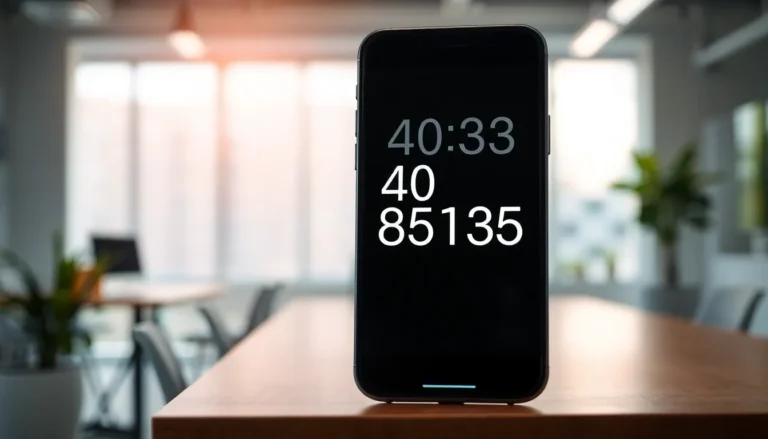Imagine this: you’re deep in a Netflix binge, popcorn in hand, when suddenly your phone blares like a fire alarm. What’s going on? That’s the magic of critical alerts on iPhone. They’re not just your average notifications; they’re the ones that cut through the noise, ensuring you never miss something important—like your mom’s urgent text about dinner or a weather warning that could ruin your weekend plans.
Table of Contents
ToggleWhat Is Critical Alerts on iPhone
Critical alerts on iPhone refer to special notifications designed to bypass the user’s Do Not Disturb settings. These alerts ensure that vital information reaches users promptly, even when other notifications are silenced. Primarily used for emergencies, critical alerts can include life-saving messages like severe weather warnings, emergency alerts from local authorities, or health notifications from medical applications.
Applications that utilize critical alerts must meet specific criteria set by Apple. Developers aiming to use these features need to submit a request that justifies the necessity of such alerts for their users. Reasons for needing critical alerts typically include enhancing safety, providing timely information, or ensuring user well-being during critical situations.
Critical alerts possess unique characteristics. Unlike standard notifications that can be ignored or missed, these alerts ensure immediate attention through sound and vibration. Users encounter them as auditory notifications alongside visual cues on the screen. The design focuses on making sure that vital notifications do not blend with everyday alerts, which could lead to potential oversights.
To manage critical alerts, users can configure settings in their iPhone. Through the Settings app, they can view which apps utilize critical alerts and make adjustments per their preferences. This organization allows users to maintain control over which notifications demand immediate attention, enhancing their overall experience and safety on the device.
Importance of Critical Alerts
Critical alerts play a vital role in ensuring timely and effective communication, especially during emergencies.
Ensuring User Safety
User safety remains a top priority with critical alerts. These alerts deliver urgent notifications directly, circumventing Do Not Disturb settings. It ensures that essential messages reach users when they’re most needed. Examples include severe weather warnings or emergency notifications. Health-related alerts can also inform users about critical updates from medical apps. Users stay informed, allowing them to take necessary actions promptly. Accessing crucial information quickly can make a significant difference in emergency situations.
Differentiating from Other Notifications
Critical alerts stand apart from standard notifications. They possess distinctive characteristics that grab attention immediately. Loud sounds and unique vibrations accompany these alerts, minimizing the risk of blending in with typical notifications. Unlike regular notifications, critical alerts cause interruptions to ensure users notice important information. Developers must meet stringent criteria established by Apple, ensuring these alerts serve a genuine need. Users manage their preferences easily through the Settings app, helping them control the importance of the information they receive.
How to Enable Critical Alerts
Enabling critical alerts on an iPhone allows users to receive urgent notifications even when in Do Not Disturb mode. Follow this simple guide to activate this important feature.
Step-by-Step Guide
- Open the Settings app on the iPhone.
- Scroll down and select Notifications.
- Locate and choose the app requiring critical alerts.
- Toggle on Critical Alerts if available.
- Confirm the selection by enabling the necessary notifications.
After completing these steps, critical alerts will bypass silencing settings and ensure vital information reaches users without delay.
Privacy Considerations
Enabling critical alerts introduces some privacy considerations. Users must trust that apps will use this feature appropriately and only for necessary notifications. Check app permissions to limit access based on preferences. Review how frequently apps send critical alerts to avoid notification overload.
Evaluating notification settings helps maintain control over personal information and privacy while ensuring important alerts do not go unnoticed.
Common Use Cases
Critical alerts on iPhone serve various essential functions. Emergency services often utilize these alerts to notify users of severe weather conditions. For example, a critical alert can trigger during tornado watches, flooding, or severe thunderstorms, ensuring immediate awareness and response.
Healthcare applications also take advantage of critical alerts. Patients might receive vital medication reminders or health notifications that require user action. Such prompts can be critical for adhering to treatment plans, emphasizing their importance in health management.
In public safety scenarios, local authorities leverage critical alerts for emergency news. Messages concerning evacuations, road closures, or public safety threats can reach users directly. This timely information can be lifesaving during urgent situations, especially for those in affected areas.
Family and personal communication highlights another critical use case. Users can receive crucial messages from loved ones in times of crisis. This could include alerts about accidents, medical emergencies, or other unforeseen events that necessitate immediate attention.
Critical alerts also enhance transportation safety. Users may receive notifications regarding delays or cancellations from public transit systems or flight services. Such information allows users to adjust their plans promptly, minimizing disruptions in their daily routines.
Businesses can implement critical alerts to notify employees about urgent operational changes. In industries like manufacturing or healthcare, immediate communication can influence productivity and safety directly. Information concerning equipment failure or safety hazards needs to reach team members without delay.
Users can tailor these alerts to fit their needs through the Settings app. Individual preferences play a role in deciding which apps can send critical notifications. Managing these settings ensures users receive only the most pertinent information, enhancing their experience with the device.
Critical alerts on iPhone play a crucial role in ensuring users receive essential notifications during emergencies. By bypassing Do Not Disturb settings, these alerts guarantee that vital information reaches users promptly. Whether it’s a severe weather warning or an important message from a loved one, the distinctive sounds and vibrations of critical alerts help prioritize user safety.
With the ability to manage these alerts through the Settings app, users can tailor their notification preferences to ensure they only receive the most important information. This feature not only enhances communication during critical moments but also promotes a sense of security and awareness in an increasingly busy world. By understanding and utilizing critical alerts, users can stay informed and prepared for any situation.


